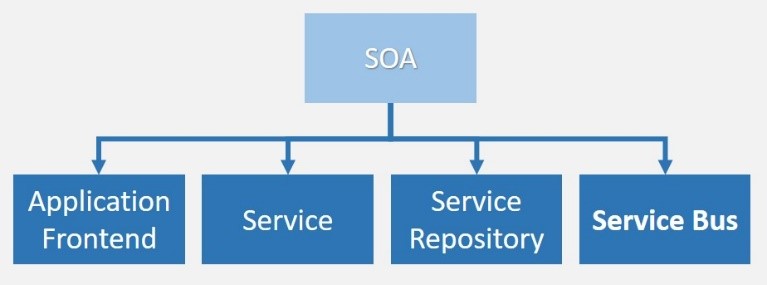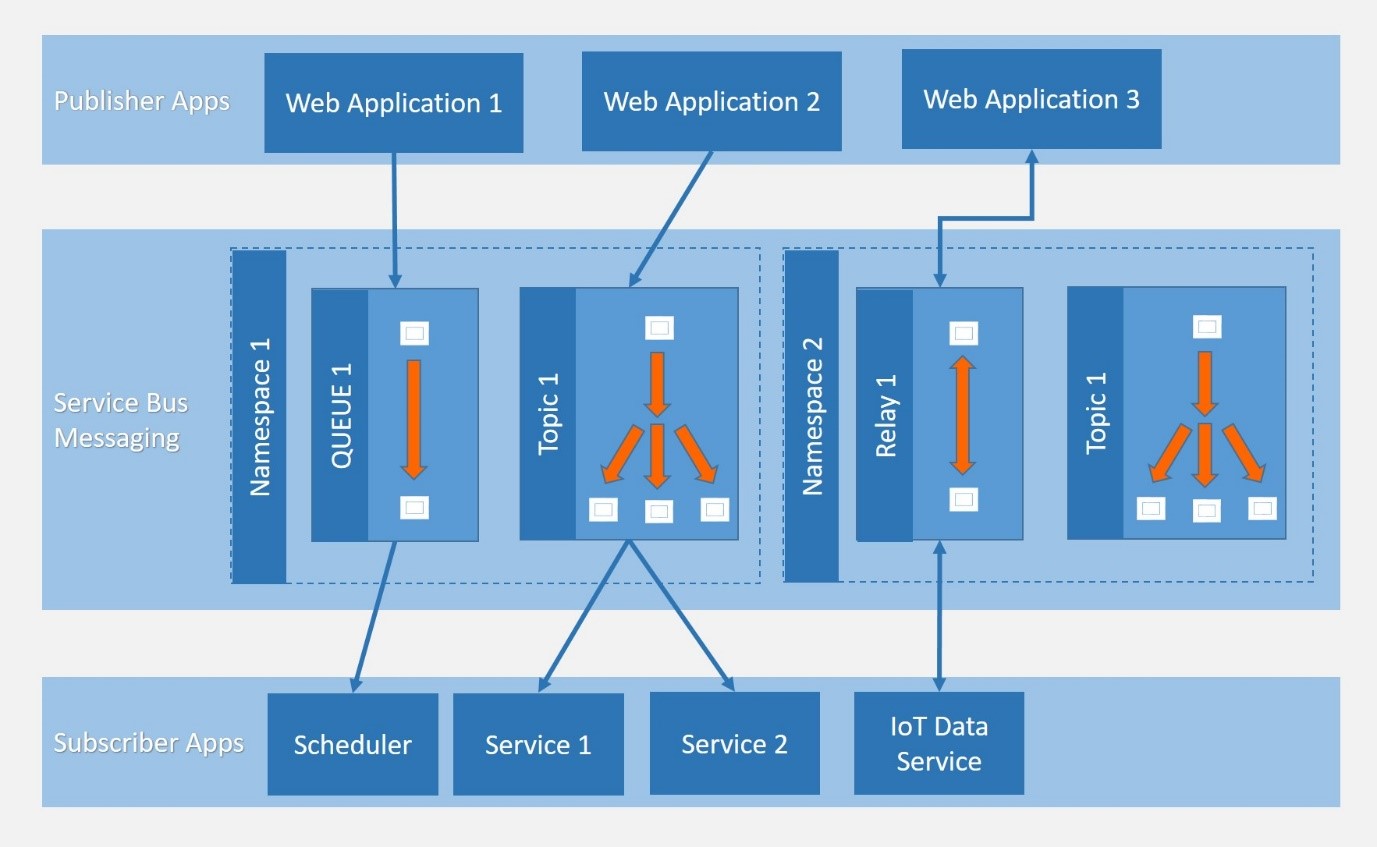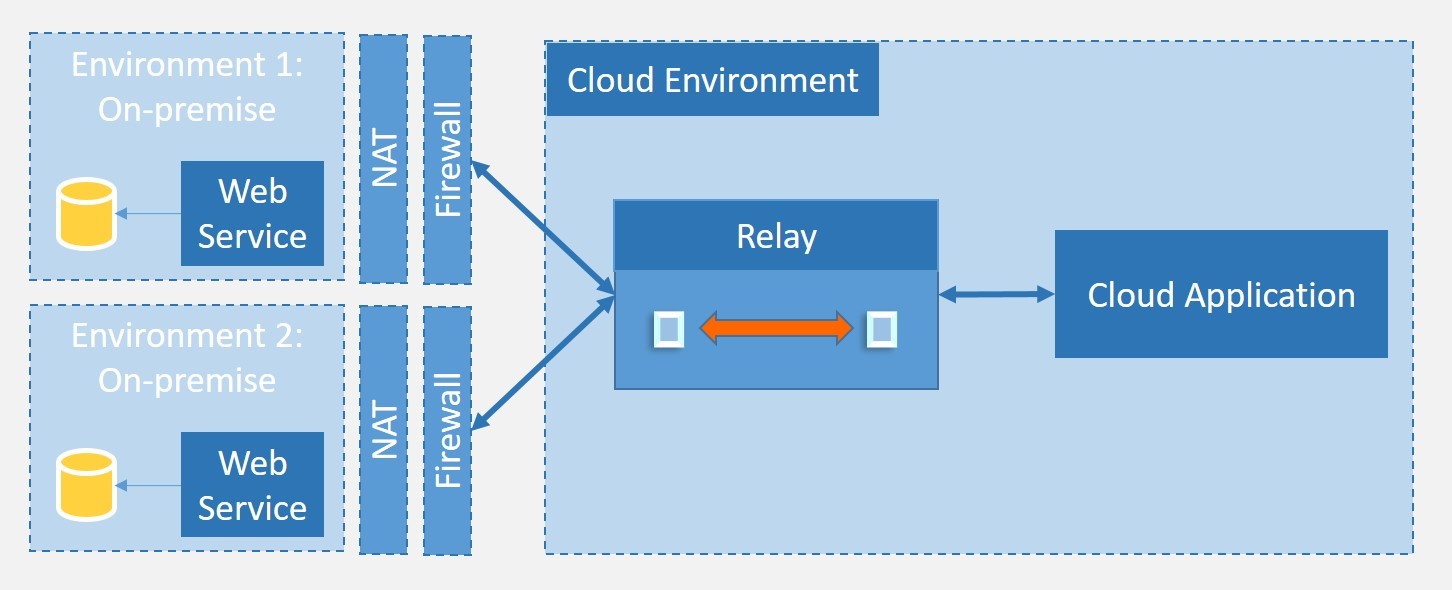How Does Azure Service Bus Work
What is an Azure Service Double-decker? A Cloud Messaging Service

Software applications have different components like front end-terminate app, backend web services, schedulers etc. SOA (software-oriented architecture) proposes a design for software implementations where these components can communicate with each other past application components through communication protocol over a network. These awarding components tin be visualized as Service Motorbus.

Figure 1: SOA Components
Azure Service Bus is a fully managed multi-tenant cloud messaging service (MAAS). Information technology is brokered messaging system. Applications and services tin communicate with each other using letters via Service Motorbus. Bulletin consists of two parts; message properties and message payload. Message backdrop is a dictionary of values against property keys. Message payload is in binary format, which can contain JSON, XML, or text information.
Architecture
Azure Service Omnibus offers three types of communication mechanisms; queues, topics and, relays. Queues and Topics, facilitate one-directional communication. Letters will be stored until they are consumed. Each message in Queue is received by a single recipient. Topic tin can take multiple subscriptions for multiple receivers. Subscriptions tin choose to receive messages based on parameters. Messages from Queues and Topics tin can be accessed using Service bus-defined messaging APIs or Balance APIs. SDKs are also bachelor for other languages. Different Queues and Topics; Relays provide bi-directional communication and does not store messages.
To utilize these messaging services, user must create namespace under Azure subscription. A namespace can be visualized as a logical container for messaging components. Multiple Service Bus components (queues, topics and relays) can reside within a single namespace.

Figure ii: Architecture - Arrangement implementation using Azure Service Omnibus components
Why Service Bus
As Azure Service Motorbus is fully managed service, scaling and availability will be taken care past Azure team. It is integrated with other Azure services similar, Event Grid, Logic Apps, Stream Analytics etc. Azure Service Bus provides reliable and secure asynchronous message communication platform along with facility of delayed processing of events or data. Shared Access Signatures (SAS), Role Based Access Control (RBAC) and Managed Service Identity (MSI) protocols are supported past it. Service Motorcoach also supports client libraries for .Cyberspace, Java, JMS.
Service Bus Tiers with Features
Features of Service Bus are available in ii tiers; Premium and Standard.
-
Standard tier
Information technology can exist used for initial development and QA environment deployments. Latency and throughput in Standard tier are variable, hence performance is not predictable. In built scaling is besides non available and maximum message size is upto 256 kb.
-
Premium tier
It tin can exist used for Production deployments. It provides loftier throughput and auto scaling for variable workloads. Maximum message size tin can exist up to 1mb. Premium name spaces provides CPU and retentiveness level isolation for resources. Functioning of Premium tier resources at peak load is much faster than Standard ones.
Service Bus Services
-
Queues
Equally name suggest, Queues messaging service offers First In First Out information delivery. It enables ordered handling of unbounded sequences of related messages. Message sessions is used to ensure a kickoff-in, first-out (FIFO). Queues enable us to shop messages until the receiving awarding is available to receive and process them. Letters in queues are timestamped on arrival and ordered co-ordinate to it. Letters are delivered on request (Pull mode delivery). Queue is frequently used for point-to-point advice.
Messages from a Service Bus queue can exist deleted immediately afterward reading. But if receiver app fails while processing then that message is lost. To avoid this situation, nosotros can go for Peek Lock option. After receiving, it makes bulletin invisible/locked for other receivers. If receiver processes message successfully, it will invoke Consummate() function and message will exist removed from queue. If receiver fails to process or does not respond within specified time interval, Abandon() function will be invoked and bulletin volition be bachelor for other receivers.
Lets accept an case, where people are ordering food from online website application. When user done with ordering, message with order menu will be pushed into Queue by application. Gild processing application will consume messages from Queue and process it i by one for delivery. Here nutrient order must be processed in sequence. Hence, Queue is perfect choice to choose.

Figure 3: Nutrient delivery app architecture using Service Bus Queue -
Topics
Topics is nothing but single input queue merely multiple output queues. Output queues are nothing merely Subscriptions. Receiving apps needs to create subscriptions to receive messages from Topic. Subscription tin can filter out the messages based on rules on message properties. Publish/subscribe scenarios tin can be implemented using Topics.
Let us utilize aforementioned instance, which nosotros have discussed higher up. At present we require high throughput while processing incoming orders. Here we can add together multiple order processing applications, which will be reading same message queue. Information technology is not possible to have multiple receivers for a Queue. Hence, we volition create different subscriptions based on restaurant selected in order and procedure them differently. Subscription volition filter the letters from Topic by restaurant name. Each social club processing application will read message from corresponding subscription.

Effigy four: Food delivery app compages using Service Double-decker Topic and Subscriptions -
Relays
Queues and Topics provides unidirectional messaging. To facilitate bi-directional communication, Azure provides Relay messaging service. In Queues or Topics there is no explicit connection between sender and receiver. However, for relays, each awarding will create outbound TCP connection to Service Bus. All communication happens using WCF (Windows communication Foundation).
Nosotros do not need to create relays explicitly. Relay volition be created when application established connection to Service Autobus. Thought of providing Relay method is to connect applications irrespective of their deployment environment. Some of the applications are deployed to unlike on premise data centers. To connect these applications for advice is not trivial task of development as well as configuration. To provide straight communication betwixt applications without much effort, nosotros can go for Azure Service Bus Relays.

Figure v: System Block diagram using Service Double-decker Relay
Service Autobus Queues vs Storage Queues
Azure supports two types of queue mechanisms: Storage queues and Service Autobus queues. Storage queues are part of the Azure storage and Service Bus queues are part of Azure messaging infrastructure.
Similarities
-
Both guarantee At-least-once commitment of message.
-
We tin receive messages in batch from both the services.
-
Both supports In-place update of messages.
Differences
-
Service Jitney queues guarantee ordered delivery of letters (timestamp based) using bulletin session.
-
Service Bus Queue allows batched send of messages.
-
State can exist managed in Service Charabanc Queue messaging.
-
You can create unlimited number of Storage Queues, but 10k Service Bus per namespace queues.
-
Service Bus Queue supports Automatic dead lettering for messages that cannot be processed or delivered.
-
In Storage Queues, lock timeout can be applied at message level; in Service Bus information technology is practical at Queue level.
Service Bus Queues vs Topics
Similarities
-
Supports unidirectional communication.
-
Supports FIFO message delivery.
Differences
-
Queues tin be used for one to ane communication just Topics tin exist used for i to many communication scenario.
-
Receivers needs to subscribe for topics and optionally needs to specify rules.
Summary
Service Charabanc Messaging service has a lot to offering, nosotros cannot encompass its all capabilities in single article. There are Paired Namespaces, AMQP back up, Partitioned Queues and many more. In short, Azure Service Autobus helps us to build our loosely coupled software components with less deployment efforts and with loftier Scalability and Availability of communication. By providing three different types of services, information technology enables architect/developer to implement different communication scenarios.
Dot Net Tricks Azure online training is delivered by Microsoft MVP Mr Shailendra to aid y'all earn azure real-fourth dimension focused Paw'southward-on skills and become azure certification
Share Article
Take our free skill tests to evaluate your skill!

In less than five minutes, with our skill examination, you lot can identify your knowledge gaps and strengths.
How Does Azure Service Bus Work,
Source: https://www.dotnettricks.com/learn/azure/service-bus-architecture-components-features
Posted by: goodwinbutenway.blogspot.com


0 Response to "How Does Azure Service Bus Work"
Post a Comment